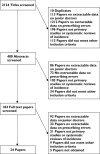What is the scale of prescribing errors committed by junior doctors? A systematic review
- PMID: 19094162
- PMCID: PMC2723201
- DOI: 10.1111/j.1365-2125.2008.03330.x
What is the scale of prescribing errors committed by junior doctors? A systematic review
Abstract
Aims: Prescribing errors are an important cause of patient safety incidents, generally considered to be made more frequently by junior doctors, but prevalence and causality are unclear. In order to inform the design of an educational intervention, a systematic review of the literature on prescribing errors made by junior doctors was undertaken.
Methods: Searches were undertaken using the following databases: MEDLINE; EMBASE; Science and Social Sciences Citation Index; CINAHL; Health Management Information Consortium; PsychINFO; ISI Proceedings; The Proceedings of the British Pharmacological Society; Cochrane Library; National Research Register; Current Controlled Trials; and Index to Theses. Studies were selected if they reported prescribing errors committed by junior doctors in primary or secondary care, were in English, published since 1990 and undertaken in Western Europe, North America or Australasia.
Results: Twenty-four studies meeting the inclusion criteria were identified. The range of error rates was 2-514 per 1000 items prescribed and 4.2-82% of patients or charts reviewed. Considerable variation was seen in design, methods, error definitions and error rates reported.
Conclusions: The review reveals a widespread problem that does not appear to be associated with different training models, healthcare systems or infrastructure. There was a range of designs, methods, error definitions and error rates, making meaningful conclusions difficult. No definitive study of prescribing errors has yet been conducted, and is urgently needed to provide reliable baseline data for interventions aimed at reducing errors. It is vital that future research is well constructed and generalizable using standard definitions and methods.
References
-
- National Patient Safety Agency. Patient safety incident reports in the NHS: National Reporting and Learning System Data Summary. Issue 7. Available at http://www.npsa.nhs.uk/patientsafety/patient-safety-incident-data/quarte... (last accessed 19 May 2008.
-
- Reason J. Human Error. Cambridge: University of Cambridge; 1990.
-
- Dean B, Schachter M, Vincent C, Barber N. Causes of prescribing errors in hospital inpatients: a prospective study. Lancet. 2002;359:1373–8. - PubMed
-
- Franklin BD, Vincent C, Schachter M, Barber N. The incidence of prescribing errors in hospital inpatients: an overview of the research methods. Drug Saf. 2005;28:891–900. - PubMed
Publication types
MeSH terms
LinkOut - more resources
Full Text Sources
Medical


